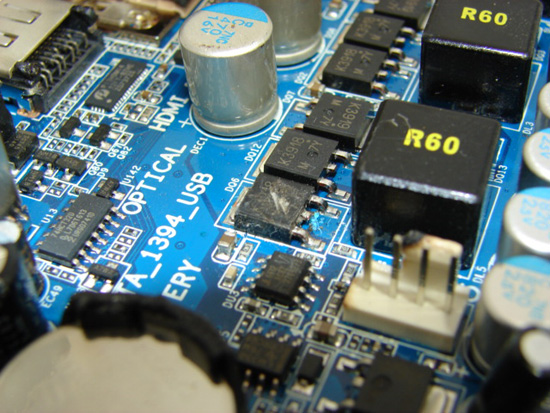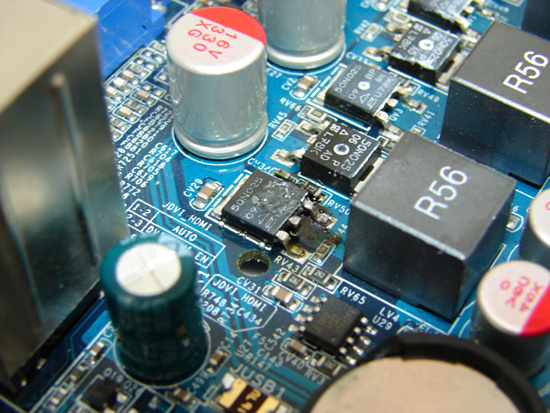AMD's Phenom X4 9950, 9350e and 9150e: Lower Prices, Voltage Tricks and Strange Behavior
by Anand Lal Shimpi & Gary Key on July 1, 2008 12:00 AM EST- Posted in
- CPUs
Overclocking or Overcooking?
We had some interesting experiences during our overclock testing. Let's just say in the motherboard section of the labs that a halon fire extinguisher is now a standard item on the test bench. Call us unlucky, abusive, or having just dumb luck, but our results these past few weeks when overclocking IGP setups has not been good. In fact, it has been downright terrible as of this week. Editors other than those who normally test motherboards had the opportunity to experience the joy of random resets and failures. After reporting extensively on the failures we experienced when using 125W TDP processors on the first release of 780G IGP boards, we thought the worse was over when the manufacturers responded with beefed up designs, BIOS updates, or officially acknowledging that certain boards were just not capable of handling the 125W TDP processors. In fact, we had not experienced any real problems with the replacement boards as we finally finished testing for the IGP roundup and looked forward to new boards featuring 140W TDP capabilities later this summer.

This 780G died while trying to overclock the Phenom X4 9350e. There's a twinge of burnt plastic on the fan header and HDMI port as well as the dead MOSFET itself.
We are still investigating, but the constant stress of 24/7 overclocking along with us trying to dial in that perfect group of settings which invariably means we push the board beyond its boundaries probably lead to our failures. While we were extremely upset for a variety of reasons (valid ones at that) when our first failures happened several weeks ago, today we are a bit amused with it actually. You see, it is not every week when you can go through five boards in less than 48 hours while trying to make an article deadline. We know three of the boards played pop goes the MOSFET as the pictures indicate, the other two died of natural causes that cannot be explained right now. In fact, it was a mix of chipsets this time from various manufacturers. Maybe the perfect storm hit us at a very inopportune time, but one lesson we have learned is that when testing overclocks in a fully loaded uATX case, it is not easy to get the marshmallows out and in place when the flames arrive.

This 780G also faced an untimely death, although the damage was contained to just the MOSFET. Either way, the board is dead.
In all seriousness, the cooling of the MOSFET/PWM area is critical when utilizing a high watt TDP processor or when overclocking a midrange Phenom CPU on these boards. It does not matter if it is a NVIDIA or AMD chipset as we have had both fail (some more spectacularly than others). We heavily suggest refraining from overclocking these processors on current IGP products unless you properly cool the MOSFET/PWM area or just do not overclock at all. While we lost several boards during the completion of this article, we would like to add that several others have not experienced a single problem to date while overclocking on an open test bench or in our test case with plenty of airflow across the board. In our opinion, it comes down to solid component choices on the board and maximizing airflow to get the most out of these boards when overclocking. In addition, none of the ATX boards based on the 790FX, 780a, or 750a has failed us while being asked to overclock at significantly higher voltages in most cases. That said, whether through BIOS immaturity or design, we did not have the best of luck with the 9950BE on the full size boards.










36 Comments
View All Comments
Gikaseixas - Wednesday, July 2, 2008 - link
Other sites tested it already and could hit 3.2 - 3.6 speeds. Hopefully Anandtech will be able to overclock a Phenom to it's limits this time around.Googer - Wednesday, July 2, 2008 - link
Missing from the benchmarks is the Intel Core 2 Quad Q9550 Yorkfield 2.83GHz 12MB. How would this chip stack up against all others tested?http://www.newegg.com/Product/Product.aspx?Item=N8...">http://www.newegg.com/Product/Product.aspx?Item=N8...
RamarC - Wednesday, July 2, 2008 - link
the q9550 isn't in the same price range as the other processors so that's why it wasn't included. as for performance, either subtract or add 10% to the q9450's figures.DanD85 - Wednesday, July 2, 2008 - link
Are you absolutely sure about that? As hothardware thinks differently:"By altering its multiplier and increasing the CPU voltage to 1.45v, we were able to take our Phenom X4 9950 to an respectable 3.1GHz using nothing but a stock AMD PIB cooler. Higher frequencies were possible, but we couldn't keep the system 100% stable, so we backed things down to 3.1GHz. While running at that speed, we re-ran some tests and also monitored core temperatures and found that the chip never broke the 60ºC mark, and hovered around 58ºC under load - at least according to AMD's Overdrive software. That is one heck of an overclock and relatively cool temperatures for a Phenom in our opinion. If the majority of chips have the same amount of headroom as ours, we suspect the 9950 Black Edition will be appealing to AMD CPU enthusiasts looking for the best the company has to offer."
http://www.hothardware.com/Articles/AMD_Phenom_X4_...">http://www.hothardware.com/Articles/AMD...nom_X4_9...
KaarlisK - Wednesday, July 2, 2008 - link
Maybe by setting affinity for Photoshop's threads to a certain core, it would be possible to verify whether Vista's thread management is part of the cause?Zoomer - Wednesday, July 2, 2008 - link
I know its a novel concept, but what about running some benches in XP to see if it's another Vista issue?Rhoxed - Wednesday, July 2, 2008 - link
Increasing the NB core (IMC) clock (in Phenom it runs async from the Core Speed unlike Athlon which is Sync) drops latencies (especially L3) and increases memory performance/throughput, which in turn improves system performance. The Phenom starts to come to life when you hit a 2.6GHz core speed with a NB core clock at 2200MHz+. Depending on the application and CPU, increasing NB core speeds (getting up to 2200MHz+) can result in performance differences from 3%~12% in most cases.Upping my NB/HT to 2400MHz over the stock 2000 at the same clockspeed (2800) i net a 15%~ increase (on a 9850BE)
RamarC - Tuesday, July 1, 2008 - link
i'm a developer and want to upgrade my win2k3/ss2k5 server to a quad core. since it currently has a 3.4ghz p4d, a phenom 9x50 would be a big step-up (even though i don't have any performance issues). but the p4d has been very reliable and i don't want to have to deal with flaky hardware issues when i'm pushing code out the door. should i just bite the bullet and shell out the extra cash for a p45+q9450?Calin - Wednesday, July 2, 2008 - link
I have an AMD based PC at home, and I look forward to another AMD-based pc (780G and Phenom X3 or X4).These being said, I think for a server you really really should go for an Intel configuration. Also, at 3.4 GHz a P4D probably is one hell of a power draw.
Compared to your current server, and based on what I think you need, I don't think a quad core would help you - a dual core would probably be enough, and Intel has those aplenty.
Zoomer - Wednesday, July 2, 2008 - link
From the article, it seems like sticking to the cheaper, sub 100W TDP cpus and not overclocking is the way to go.